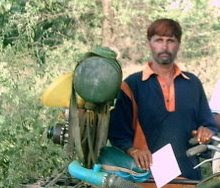Thursday, October 30, 2008
Throw Out the Pesticide Safety Baby With The Sea Water
Genetic Engineering, Agronomy, and Pesticide Safety
Wednesday, October 29, 2008
A Typical Pesticide Safety Case
Monday, October 27, 2008
Children and Pesticide Safety
 Date: October 23, 2008
Date: October 23, 2008Sunday, October 26, 2008
A Pesticide Safety Guarantee from Farmers to City Folk

Saturday, October 25, 2008
Pesticide Safety for the Skin




Friday, October 24, 2008
Biologicals Should Replace Chemical Pesticides at Harvest for Safety

Thursday, October 23, 2008
Infrastructure for Pesticide Safety

Wednesday, October 22, 2008
Pesticide Safety Has Me Over The Moon

Tuesday, October 21, 2008
Should Pesticide Safety Have Spatial Limits?
Monday, October 20, 2008
A Database Approach to Chronic Aspects of Pesticide Safety

Sunday, October 19, 2008
Networking for Pesticide Safety
Saturday, October 18, 2008
No Pesticide Safety in a Tank Mix
Friday, October 17, 2008
Pesticide Safety is Good for Business
Thursday, October 16, 2008
Are You An Obstacle to Pesticide Safety?
Wednesday, October 15, 2008
A Tribute to a Pesticide Safety Champion
Tuesday, October 14, 2008
Use, Abuse, and Pesticide Safety
Sunday, October 12, 2008
A Consumer Perspective of Pesticide Safety
A New Pesticide Safety Dimension
Friday, October 10, 2008
The Efficacy and Pesticide Safety Link
There are many theories as to why biological pesticides have not been successful. I believe that it is a matter of professional and dedicated transfer of technology. Consider the disturbing news at the following link:
http://www.newvision.co.ug/D/8/220/653837
I am not aware whether the biological pesticides used in this case were of inferior quality. Perhaps colony releases were not on time. Another factor to consider is whether the farmers wanted knock-down action, though what they choose to use were repellants.
Biological pesticides have to be used in a system format. The Endogram-Endocel-Endosulfan tolerant Chrysoperla is my triad of choice. I am confident of protecting crops from insect attacks using this approach. A bonus is that honeybees and other pollinators can go about their tasks.
Post below or write to me at sochiye.pesticidesafety@gmail.com if you would like to try the Endogram-Endocel-Endosulfan tolerant Chrysoperla system.
Thursday, October 9, 2008
Pesticide Safety Beats Organic
Honest Labeling for Pesticide Safety
Tuesday, October 7, 2008
A Must for Pesticide Safety
Monday, October 6, 2008
Seize the Pesticide Safety Initiative
Sunday, October 5, 2008
A Spiritual Basis for My Pesticide Safety Campaign
 The meeting was not in the best of circumstances. A sudden illness in the family was responsible for the Darshan. Nevertheless, it was inspiring as always.
The meeting was not in the best of circumstances. A sudden illness in the family was responsible for the Darshan. Nevertheless, it was inspiring as always.
